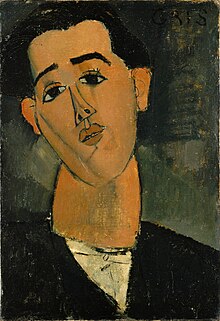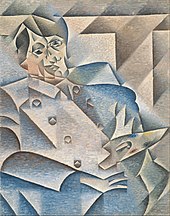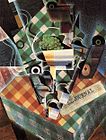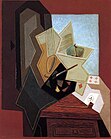Juan Gris
Juan Gris | |
|---|---|
 Amedeo Modigliani, Portrait of Juan Gris, 1915, Metropolitan Museum of Art | |
| Born | José Victoriano González-Pérez March 23, 1887 |
| Died | May 11, 1927 (aged 40) |
| Nationality | Spanish |
| Known for | Painting, sculpture |
| Movement | Cubism |
José Victoriano (Carmelo Carlos) González-Pérez (March 23, 1887 – May 11, 1927), better known as Juan Gris (Spanish pronunciation: [ˈxwaŋ ˈgɾis]), was a Spanish painter and sculptor who lived and worked in France most of his life. His works, which are closely connected to an innovative artistic genre—Cubism—are among the movement's most distinctive.[1]
Early life
Born in Madrid, Gris studied mechanical drawing at the Escuela de Artes y Manufacturas in Madrid from 1902 to 1904, during which time he contributed drawings to local periodicals. From 1904 to 1905, he studied painting with the academic artist José Maria Carbonero. It was in 1905 that José González adopted the more distinctive name Juan Gris.[2]
Career
In 1906 he moved to Paris and became friends with Henri Matisse, Georges Braque, Fernand Léger, then in 1915 he was painted by his friend, Amedeo Modigliani. In Paris, Gris followed the lead of another friend and fellow countryman, Pablo Picasso. He submitted darkly humorous illustrations to journals such as Le Rire, L'assiette au beurre, Le Charivari, and Le Cri de Paris. Gris began to paint seriously in 1911 (when he gave up working as a satirical cartoonist), developing at this time a personal Cubist style. In A Life of Picasso, John Richardson writes that Jean Metzinger's 1911 work, Le goûter (Tea Time), persuaded Juan Gris of the importance of mathematics (numbers) in painting.[3] As Brooke points out, Gris started painting persistently in 1911 and first exhibited at the 1912 Salon des Indépendants (a painting entitled Hommage à Pablo Picasso). "He appears with two styles", writes Brooke, "In one of them a grid structure appears that is clearly reminiscent of the Goûter and of Metzinger's later work in 1912."[4] In the other, Brooke continues, "the grid is still present but the lines are not stated and their continuity is broken. Their presence is suggested by the heavy, often triangular, shading of the angles between them... Both styles are distinguished from the work of Picasso and Braque by their clear, rational and measurable quality."[4]
Although Gris regarded Picasso as a teacher, Gertrude Stein wrote in The Autobiography of Alice B. Toklas that "Juan Gris was the only person whom Picasso wished away".[5]

At first Gris painted in the analytic style of Cubism, but after 1913 he began his conversion to synthetic Cubism, of which he became a steadfast interpreter, with extensive use of papier collé or, collage. Unlike Picasso and Braque, whose Cubist works were monochromatic, Gris painted with bright harmonious colors in daring, novel combinations in the manner of his friend Matisse. Gris exhibited with the painters of the Puteaux Group in the Salon de la Section d'Or in 1912.[6] His preference for clarity and order influenced the Purist style of Amédée Ozenfant and Charles Edouard Jeanneret (Le Corbusier), and made Gris an important exemplar of the post-war "return to order" movement.[7]
Designer and theorist
In 1924, he designed ballet sets and costumes for Sergei Diaghilev and the famous Ballets Russes.
Gris articulated most of his aesthetic theories during 1924 and 1925. He delivered his definitive lecture, Des possibilités de la peinture, at the Sorbonne in 1924. Major Gris exhibitions took place at the Galerie Simon in Paris and the Galerie Flechtheim in Berlin in 1923 and at the Galerie Flechtheim in Düsseldorf in 1925.
Death
After October 1925, Gris was frequently ill with bouts of uremia and cardiac problems. He died of renal failure[8] in Boulogne-sur-Seine (Paris) on May 11, 1927, at the age of 40, leaving a wife, Josette, and a son, Georges. coccccckkkkkkk
Art market
His top auction price was $20.8 million which was set by his 1915 still life titled, Livre, pipe et verres,[1] until Christie's Imp/Mod sale in November 2010, when "Violon et guitare" sold for $28.6 million.[9]
Selected works
-
Guitar and Pipe, 1913, Dallas Museum of Art
-
Glass of Beer and Playing Cards, 1913, Columbus Museum of Art, Ohio.
-
Violin and Checkerboard, 1913, Private collection.
-
The Bottle of Anís del Mono, 1914, Queen Sofia Museum, Madrid, Spain
-
Fantômas, 1915, National Gallery of Art
-
Still Life with Checked Tablecloth, 1915, Private collection.
-
Newspaper and Fruit Dish, 1916, Yale University Art Gallery
-
The Guitar, 1918.
-
Still Life with Fruit Dish and Mandolin, 1919, Private collection, Paris.
-
Harlequin with Guitar, 1919, Galerie Louise Leiris, Paris.
-
Le Canigou, 1921, Albright-Knox Art Gallery
-
The Painter's Window, 1925, Baltimore Museum of Art
Notes and sources
- Notes
- ^ a b Marcus, J.S. "Juan Gris." June 2009, Art+Auction.
- ^ Gris 1998, p. 124.
- ^ John Richardson: A Life of Picasso, volume II, 1907-1917, The Painter of Modern Life, Jonathan Cape, London, 1996, p.211
- ^ a b Peter Brooke, On "Cubism" in context, online since 2012
- ^ After Gris' death, Stein said to Picasso, "You never realized his meaning because you did not have it", to which Picasso replied, "You know very well that I did". Caws, Mary Ann (2005). Pablo Picasso. Reaktion Books. ISBN 1-86189-247-0. p. 66
- ^ Cooper, Philip. Cubism. London: Phaidon, 1995, p. 56. ISBN 0714832502
- ^ Cowling and Mundy 1990, p. 117
- ^ Oxford Art Online, "Juan Gris"
- ^ "Juan Gris (1887-1927) | Violon et guitare | Impressionist & Modern Art Auction | 20th Century, Paintings | Christie's". Christies.com.cn. Retrieved 2012-03-23.
- Sources
- Cowling, Elizabeth; Mundy, Jennifer. 1990. On Classic Ground: Picasso, Léger, de Chirico and the New Classicism 1910-1930. London: Tate Gallery. ISBN 1-85437-043-X
- Gris, Juan. 1998. Juan Gris: peintures et dessins, 1887-1927. [Marseille]: Musées de Marseille. ISBN 2-7118-2969-3. (French language)
External links
- Juan Gris Biyografi Template:Tr icon
- www.JuanGris.org 181 works by Juan Gris
- Paintings by Juan Gris
- Artcyclopedia - Links to Gris' works
- The Athenaeum - Extensive list and images of Gris' works
- Web Museum - Biography and images of Gris' works
- OCR'd issues of Le Rire
- Juan Gris in Artfacts.Net See actual exhibitions and related galleries and museums for Juan Gris












